Neck pain is most commonly caused by poor posture which causes a strain on all the soft tissues such as muscles and ligaments that support the neck.
A strain occurs when the head is held forwards well in front of the shoulders.
For every inch the head shifts forwards, an extra 10 lbs of stress is added to the muscles in the upper back and neck. A 5-inch forward shift results in 50 lbs extra of force.
The normal posture of the neck is when the ears are positioned over the shoulders and the chest should be open and the shoulders back and relaxed down. In this normal head posture, there will be a slight curve of the neck, but the weight of the head will be perfectly balanced and cause the minimum stress on the muscles and joints.
When the head is held forward of this position i.e the ears are held well in front of the shoulders the muscles in the neck and upper back have to continually overwork to counterbalance the pull of gravity on the forward head. The result of this is that the muscles become more susceptible to painful strains and spasms.
This head forwards posture causes two problems- too much flexion at the lower end of the neck and too much extension at the upper part of the neck.
This alteration of the curve lengthens the spinal canal distance from the base of the skull to the base of the neck which in turn causes the spinal cord and nearby nerve roots to become somewhat stretched.

How to avoid neck strain
Think of your posture
Sit well back in the chair and if working on a computer make sure that your computer monitor is at eye level.
Sit comfortably in front of your computer and close your eyes. When you open them, your gaze should be directly in the top-third of your computer screen. If you find you have to look down, then you need to raise your monitor up.
Laptops most often require you to angle your head downward to see the screen, so connecting your laptop to a separate monitor, or screen, is often very helpful.
Avoid neck strain from texting
Texting or looking down at your mobile phone for any length of time puts a huge strain on your neck. Over time this added stress on your neck can lead to premature degenerative changes. To avoid neck damage from texting lift your phone up to eye level and try to limit the time you spend on your phone.
Use a headset
If you need to spend a lot of time on the phone, at work or at home try and avoid tilting your head to the side and holding your phone in the crook of your neck. A headset is a good way to resolve the issue.
Carry weight evenly
A common mistake people make is carrying a heavy handbag or briefcase on one side of their body which can cause your shoulders to become uneven and strain your neck muscles. It is best to limit the weight of your bag or use a rucksack.
Take regular breaks from the computer– Stand up if possible and stretch your arms above your head. Also perform regular necks exercises which can be done whilst sitting at the computer. See exercise sheet

Sleeping-Try a new pillow
Pillows are quite personal and so you may need some trial and error before you find the right one for you. Generally, it is best to use a pillow that keeps your cervical spine (neck) in neutral alignment i.e the natural curve of your neck is supported and maintained.
Some people find that their neck pain decreases when they lie down on their back with the head supported by a relatively flat pillow, or with an orthopedic pillow that has a deeper depression where the head lies and extra support under the neck.
Other people find that support with a pillow when side-lying is more comfortable.
Most people move position during the night so you may need a different solution for both positions.
Sleep on your back if you can.
In general, sleeping on your back is the best position to let your whole spine rest comfortably.
Some people with spinal arthritis or stenosis may find that sleeping at a slight incline is easier. In these cases, they can add a foam wedge pillow to their bed or switch to an adjustable bed.
Sleeping on your side
make sure your pillow is not too high and aim is to keep your head in neck in a neutral position i.e not side bending
The size of the pillow will depend on your frame and the type of pillow you use.
If this does not help try rolling up a towel and place under the neck with your head resting on the pillow as normal.
Exercises to do
The exercises below help loosen up the upper part of your thoracic spine and your neck which are often tight if you have been sitting a lot.
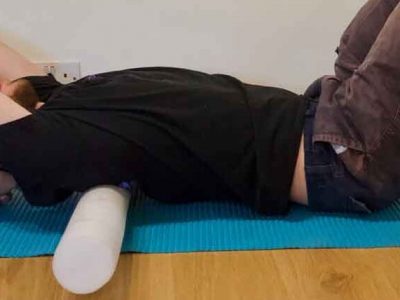
Stretches over a roll or small ball
This eases stiffness from poor posture in the upper/ middle back which in turn helps neck posture.
This can also be done over a small ball directing the ball to areas of stiffness and pain.
You can also roll backwards over the arm of a sofa
Neck exercises
This Forward head posture is often accompanied by round shoulders and a rounded upper back which can lead to more pain in the neck, upper back and shoulders.
Chin Tuck
One of the most effective postural exercises for combating neck pain is the chin tuck exercise. This exercise helps strengthen the muscles that pull the head back into alignment over the shoulders (upper thoracic extensors) and also stretches the scalene and suboccipital muscles.
Chin tucks can be done as often as you like throughout the day, such as while sitting in the car or at the desk at work. The repetition of this exercise throughout the day also helps develop good postural habits.
Initially this is best learnt standing against the wall but once perfected can be done in any position.
Stand with your back and the crown of your head against the wall. Keeping the crown of the head in contact with the wall at all times try and retract your chin inwards flattening the neck at the back towards the wall.
You should try and imagine something is pulling the crown of your head vertically up so your spine is being stretched upwards.
Relieve trigger-point pain by self massage
Poor posture leads to a strain in the muscles which in turn may result in muscle trigger points which are small knots in the muscle or surrounding tissue that can lead to pain. You can try and massage these trigger points yourself to ease the pain using a small ball. Lean up against the wall placing the ball on the correct spot, then using your legs move up and down over the ball.



Neck flexion
Bring chin towards your chest. Now pull it a little further with your hands to feel the stretch.
Repeat x 5
Neck rotation
Turn your head round to look at your shoulder and then if possible push it a little bit further with your hands x 5
Then do the other side x 5


Chin to shoulder
This time just take your chin down and out towards your shoulder.
x5 each side
Neck sidebends
Stretch your head sideways towards your shoulder and use the hand to pull it further.
Keep your eyes facing forwards at all times
x 5 each side
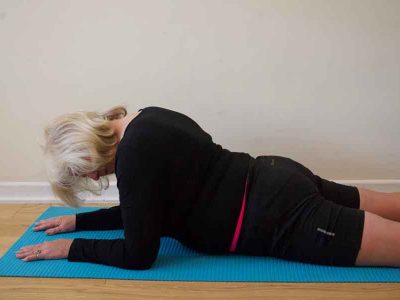
Neck stretch in prone
Lie on your front propped up on your elbows- Let the head hang down forwards and feel the stretch.
Hold 20 secs
Repeat 2-3 times
Spinal extension
Lie on your tummy with arms out straight. Now lift your head and shoulder up curling the spine up backwards.
Repeat x 10
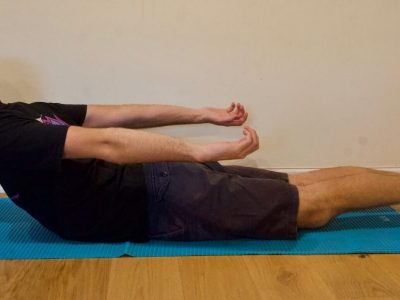
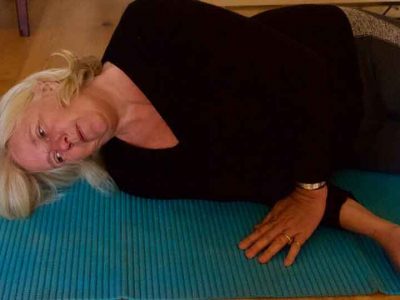
Neck sideband in lying
Lie on your side with your shoulder under you. Keeping your eyes facing straight forwards let your head lower to the floor.
Feel the stretch in the muscles on the side of your neck
Repeat x 5 each side
Chin Tucks against the wall
Stand against the wall with your shoulder, pelvis and crown of the head against the wall. Now try and retract your chin in to make a double chin and feel the crown of your head sliding up the wall.
Imagine someone is pulling you up with a rope from the top of your head.
Relax, slightly poke the chin out and then pull back in again.
Repeat x 10
This can be done in the chair easily well.
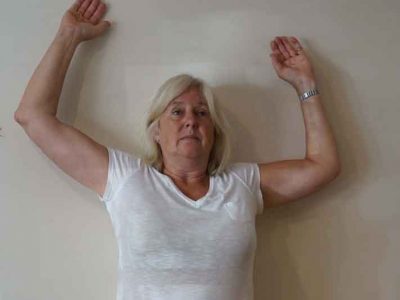
Wall slides- With arms on the wall
Another very good postural exercise is another exercise standing against the wall with the feet about 4 inches out from the bottom of the wall.
- Stand with your back and crown of your head against the wall.
- Try to flatten the lower back against the wall.
- Place the elbows, forearms and the backs of the hands and fingers on the wall with wrists about shoulder height.
- Keeping the arms, hands, head and fingers all touching the wall slide your hands up above the head and slowly back down x 10


Pingback: Cervical Spondylosis – Myhealth4life